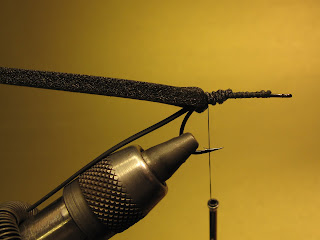Mike Schmidt of Angler's Choice Flies is an Ohio based tier and angler who is breaking new ground with his innovative fly-tying. Mike and I began corresponding a little while back. Mike was kind enough to send over a full step-by-step of his Mouseketeer fly. Enjoy the step by step and be sure to tie a Mouseketeer up for your next trip.
Recipe:
Thread: UTC140, black
Hook: Gamagatsu B10S size 2 and 4
Tail: Round rubber legs, black
Body1: Evasote sheet foam (1/8"), black
Body2: Schlappen, black
Body3: Medium foam tube, black (optional)
STEP 1: With your Gamagatsu B10S size 4 in the vise, get your black 140 denier thread started at the head and then wrap back down the hook a few wraps to secure it in place.
STEP 2: Take three connected pieces of black round rubber legs to form the mouse tail. Tie them in hanging off the back of the hook three to four inches and finish with your thread at the rear tie in point located half way between the hook point and the barb.
STEP 3: Cut a 3/4" wide strip of 1/8" thick evasote foam. Tie in the strip of foam securely with your thread ending up back at the rear tie in point.
STEP 4: At the rear tie in point secure a black schlappen feather by the tip then palmer it forward eight to ten wraps up to the head of the rear hook.
STEP 5: Split the fibers as evenly as you can down the hook shank and then pull the foam strip forward to the eye. Once you have a tight couple of wraps cut the strip off soyou can see the eye and then finish securing it with a few more wraps and a whip finish right behind the hook eye.
STEP 6: Place your Gamagatsu B10S size 2 in the vise and secure the rear of the fly using a two inch piece of 30lb Fireline. Wrap tightly up and down the shank twice with a dot of Zap a Gap to ensure the rear hook is not going anywhere.
STEP 7: Cut a arc in to another piece of foam and securely attach it at the rear tie in point. The arc should extend back and cover the eye of the rear hook. Doing so allows the hooks to swivel but keeps a solid profile from below.
STEP 8: Just in front of the foam tie in another schlappen feather and palmer it forward. Be sure to leave a bit over 1/8" of space to the hook eye then tie it off and clip.
STEP 8B: (OPTIONAL) If you are fishing faster water or simply want the pattern to sit just a little higher in the water then you can do so by adding a bit more foam to the front hook. After you tie in the schlappen then secure a piece of 1/8" evasote foam tubing. Prepare the tubing by cutting it to length and cut a slit down the length of the piece to allow it to form around the hook. Once the tubing is tied in the palmer the feather forward over the tubing.
STEP 9: As you did on the back hook, split the fibers as evenly as you can down the hook shank and then pull the foam strip forward towards the eye and secure the foam with half a dozen wraps.
STEP 10: Force a fold in the foam and tie it down just behind the eye. This piece of foam will push a significant amount of water and give you a nice big wake to attract fish.
From above you can see it really looks more like a nuclear enhanced ant…but in the water at night it holds a solid silhouette against the sky and pushes a lot of water around. Tied correctly this fly tracks like a charm and is extremely durable. When I fish this pattern I am using heavy tippet to help control both the fly and whatever eats it, and attach it using a Jam Knot as I do on most all my streamers. Tie some up and get them wet!
---------------------------------
Thanks for the great step-by-step on your Mouseketeer Mike. You can find Mike Schmidt's patterns online at Angler's Choice Flies. Mike lives in Ohio and fishes widely in the Midwest.












1 comment:
way cool!!
www.bigerrfish.blogspot.com
Post a Comment